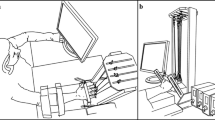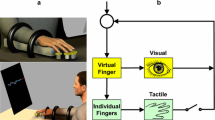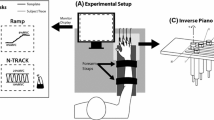Abstract.
The coordination of digits during combined force/torque production tasks was further studied using the data presented in the companion paper [Zatsiorsky et al. Biol Cybern this issue, Part I]. Optimization was performed using as criteria the cubic norms of (a) finger forces, (b) finger forces normalized with respect to the maximal forces measured in single-finger tasks, (c) finger forces normalized with respect to the maximal forces measured in a four-finger task, and (d) finger forces normalized with respect to the maximal moments that can be generated by the fingers. All four criteria failed to predict antagonist finger moments when these moments were not imposed by the task mechanics. Reconstruction of neural commands: The vector of neural commands c was reconstructed from the equation c=W −1 F, where W is the finger interconnection weight matrix and F is the vector of finger forces. The neural commands ranged from zero (no voluntary force production) to one (maximal voluntary contraction). For fingers producing moments counteracting the external torque (`agonist' fingers), the intensity of the neural commands was well correlated with the relative finger forces normalized to the maximal forces in a four-finger task. When fingers produced moments in the direction of the external torque (`antagonist' fingers), the relative finger forces were always larger than those expected from the intensity of the corresponding neural commands. The individual finger forces were decomposed into forces due to `direct' commands and forces induced by enslaving effects. Optimization of the neural commands resulted in the best correspondence between actual and predicted finger forces. The antagonist moments are, at least in part, due to enslaving effects: strong commands to agonist fingers also activated antagonist fingers.
Similar content being viewed by others
Author information
Authors and Affiliations
Additional information
Received: 8 August 2001 / Accepted in revised form: 7 February 2002
Rights and permissions
About this article
Cite this article
Zatsiorsky, V., Gregory, R. & Latash, M. Force and torque production in static multifinger prehension: biomechanics and control. II. Control. Biol Cybern 87, 40–49 (2002). https://doi.org/10.1007/s00422-002-0320-7
Issue Date:
DOI: https://doi.org/10.1007/s00422-002-0320-7




